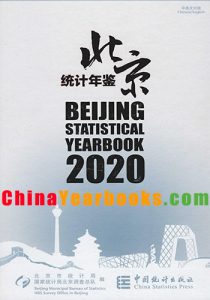Beijing Statistical Yearbook 2020 Download
Yearbook title:北京统计年鉴2020
Yearbook English title:Beijing Statistical Yearbook 2020
Published Date :09/2020
Language : English and Chinese bilingual
Availability : Printed Version;Electronic Version(PDF Version)

Beijing Statistical Yearbook is a large statistical book published continuously on a chronological basis.With a great deal of statistical data,this Yearbook gives a reflection of the economic and social development and changes in Beijing over the past year.It serves as an important reference book for domestic and foreign personnel in all circles to understand and know Beijing. Ⅰ.Framework Structure (Ⅰ) Overall Structure The overall structure of Beijing Statistical Yearbook remains stable.In color pages,the development and changing trends of main economic and social indicators of Beijing have been presented with both illustration and pictures;statistical tables are the main part of this Yearbook,mainly including 24 chapters,i.e.General Survey;National Accounts;Population and Employment;Price Index;People’s Living Conditions;Government Finance and Tax Revenues;Energy,Resources and Environment;Public Utilities;Total Investment in Fixed Assets and Real Estate Development;Foreign Economic Relations and Trade;Agriculture and Rural Economy;Industry;Construction;Tertiary Industry;Transport,Post and Telecommunication Services;Wholesale and Retail Trade,Accommodation and Restaurants;Tourism;Finance;Science and Technology;Education;Health Care and Social Services;Culture and Sports;Public Management,Social Security and Social Organizations;and Development Zones,reflecting the economic and social development situation across the city through multiple fields and industries. (Ⅱ) Structure of Chapters Internal structure of chapters in this Yearbook:Each chapter is composed of the Brief Introduction,Statistical Tables and Explanatory Notes to Main Statistical Indicators.There into,Brief Introduction appears on the first page of each chapter,mainly introducing the main content,statistical scope,indicator standards,method of adjustment to historical data in each chapter;Explanatory Notes to Statistical Indicators come on the last page of each chapter,mainly giving a brief explanation to the main indicators and calculation method,etc.involved in the chapter. Arrangement of statistical tables:In each chapter,statistical tables are arranged for the purpose of reflecting the main conditions in the field.Generally speaking,main indicators historical data tables come before current year data tables. Ⅱ.How to Use (Ⅰ) Years Conventionally,the year indicated in the title of the book is the year of publication.The latest data indicated in this Yearbook are data in the previous years.For example,this book is titled 2020 Beijing Statistical Yearbook,which means it will be published in 2020 while the latest data in the book is by the end of 2019. “Years” in the statistical tables are marked in three ways,each indicating a different meaning.Firstly,the statistical table is named“******(AAAA-BBBB)”,which refers to that the data listed in the table are those from the year of AAAA to BBBB;Secondly,the statistical table contains no years,indicating that the data listed in the table are those of current year and last year;Thirdly,the statistical table is named“******(AAAA)”,indicating that the data listed in the table are those of the year of AAAA. (Ⅱ) Symbols Symbols in statistical tables include: #:means that the item is included in the total.Grouped indicators marked with “#”are part of the total,while those without “#” mean that sum of included items equals to the total. ‖:grouping symbol,means that there are multiple ways of grouping the indicators. …:means that the figure is less than the minimum measurement unit of the table. Blank:means that the figure is unknown or unavailable. ***:When it is possible to identity or infer the identity of the individual statistical respondent based on the data,it shall be shielded and indicated with “***”. (Ⅲ) Data 1.Each chapter in this Yearbook consists of two parts:historical data tables and current year data tables.In principle,historical data that are shown in the historical data tables can be used continuously;for some historical data that have been adjusted,please refer to the latest yearbook;When using the data,it is necessary to refer to the Brief Introduction and the explanations on the change in method system,standards and scope in the Notes under the statistical tables.In the current year data tables,if the standards and scope,calculation method for the corresponding indicators,and certain data greatly differ from that of the previous year,they shall be explained in the Notes under the statistical tables. 2.In the 2020 Beijing Statistical Yearbook,the data of 2018 on gross domestic product,energy,real estate,industry,construction,services,wholesale and retail trade,research and experimental development (R&D) and other relevant fields have been supplemented,and the relevant historical data have been revised according to the results of the fourth national economic census in Beijing. 3.Compared with the 2019 Beijing Statistical Yearbook,adjustments have been made to the content of some chapters.Content related to the cultural industry has been moved to the Culture and Sports chapter.Revised historical data since 2001 on added value by sector are supplemented in the National Accounts part;historical data on natural gas consumption per RMB 10,000 of GDP and data on water used by industry above designated size by sector are added in the Energy,Resources and Environment part;historical data on trade in services are added in the Foreign Economic Relations and Trade part;historical data on PCT international patent applications,domestic patents in force and invention patents in force,and invention patent ownership per 10,000 persons,etc. are added in the Science and Technology part;historical data on educational funds are added in the Education part;historical data on added value of cultural industry and on the operation of cultural industry enterprises above designated size are added in the Culture and Sports part;and historical data on cases handled by procuratorial organs are supplemented in the Public Management,Social Security and Social Organization part. (Ⅳ) Electronic CD-ROM Beijing Statistical Yearbook is provided with a CD-ROM,which contains Chinese and English versions of this Yearbook.The CD-ROM helps users in working with and processing the data. (Ⅴ) The sum of some statistics or some relative numbers in this Yearbook might have certain calculation errors because of the choice of different units of measurement.All the statistics have not undergone mechanical adjustment.